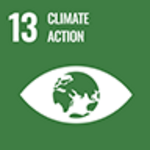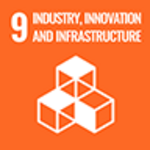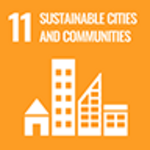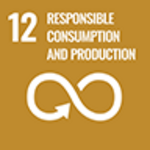
15 questions for climate change researchers asked by Associate Professor Hiroyuki Tomita (with subtitles)
The atmosphere and ocean were previously studied as separate fields: meteorology and oceanography. However, since the atmosphere and ocean are connected at the sea surface, it is necessary to consider the interaction between the two in order to understand climate. We spoke with Associate Professor Hiroyuki Tomita of Faculty of Environmental Earth Science is working on accurately estimating sea surface fluxes using observation data from satellites.
Quantifying atmosphere-ocean communication
Tomita: For example, let's say we have a diagram showing the distribution of ocean surface water temperatures obtained through observation. Temperature constantly changes over time, so hot and cold places also change from moment to moment, but it is difficult to understand why the temperature changes based on temperature data alone. One reason for this is that the ocean's surface is in contact with the atmosphere, and they exchange energy (heat) and substances (water vapor, etc.) with each other.
Therefore, we are trying to gain a deeper understanding of the relationship between the two by defining what is called "sea surface flux" at the interface between the atmosphere and ocean, and quantifying the exchange of energy and materials. Sea surface flux is, so to speak, the language of communication between the atmosphere and the ocean.
By focusing on sea surface fluxes, it becomes possible to accurately understand the ``atmosphere-sea interaction'' in which atmospheric changes affect the ocean, and conversely, ocean changes affect the atmosphere, and this helps to improve natural phenomena such as typhoons and climate change. We believe that this can lead to highly accurate predictions.

Global warming and atmosphere-ocean interactions
Tomita: It is thought that the heat generated by global warming is mainly stored inside the ocean. However, the ocean does not store heat uniformly in the depth direction; the shallower areas tend to be particularly warm. This is called "stratification," meaning that it forms layers, and it has been reported that this stratified structure tends to become stronger (stratified) in connection with global warming.
Generally, when strong winds blow over the ocean, water near the surface mixes with water at depth, but stratification works to suppress this mixing in the depth direction.
Stratification makes it easier to maintain warm water at the surface, creating a situation where evaporation from the ocean is more likely to occur. As evaporation increases, the amount of water vapor in the atmosphere increases. When the amount of water vapor in the atmosphere increases, this in turn leads to weather effects such as increased rainfall.
This is an example of how global warming changes the interaction between the atmosphere and ocean.

Photo: Melnikov Dmitriy/Shutterstock
Observation using artificial satellites
Tomita: To investigate these phenomena in detail, we complement each other with on-site observations using ships and buoys and remote sensing using satellites. The reality is that there is very little in-situ observation data, especially in the open ocean, which is difficult to access. In such places, satellites can be used to efficiently observe large areas of the ocean and estimate sea surface fluxes.
On the other hand, many of the satellite sensors I use use radio waves (microwaves), but radio waves have a property that they hardly travel through the ocean, so basically we can only obtain information near the ocean surface. . In order to investigate the interior of the ocean, it is necessary to go to the site and put sensors into the ocean to take measurements. In addition, to investigate how the heat emitted from the ocean affects the atmosphere, we must observe the interior of the atmosphere.

Observation of sea surface flux by ships and satellites. With ships (left), the number of observations is small and there are gaps, but with satellites (right), the number of observations is much higher, indicating that they can observe a wide range without gaps (Tomita, 2005).
Using the latest “J-OFURO” to grasp global trends at the same time
Tomita: J-OFURO (https://www.j-ofuro.com) is a project that estimates sea surface flux using observation data from multiple satellites. J-OFURO itself is a project that has been going on for about 20 years, and multiple researchers have been involved, but I am currently leading the project.
The third generation (J-OFURO3) dataset currently available to the public makes it possible to understand global sea surface fluxes. By looking at the entire planet, which is warming, we hope to uncover what is actually happening between the atmosphere and ocean. This kind of broad perspective is especially important when dealing with global phenomena such as climate change.
In addition, by overlapping multiple satellite observations, we have been able to see things with a higher resolution. For example, it has been discovered that a significant amount of heat is released into the atmosphere in response to strong ocean currents, and that the fine vortex-like structure of the ocean plays an important role in the exchange of heat between the atmosphere and ocean. I did.
When trying to understand nature, there is a global perspective that looks at the entire earth, and a perspective that looks at the details in detail. Complex phenomena that span various scales, such as the atmosphere and ocean, are difficult to understand from only one perspective, and I believe that it is important to have a stance that balances both perspectives in order to understand nature.

Average sea surface heat flux over the past 30 years estimated by J-OFURO3. Positive values represent heat transport from the ocean to the atmosphere.
Typhoon forecast and sea surface flux
Tomita: Recently, I have been particularly focused on research on typhoons. Typhoons are one of the meteorological phenomena that have a major impact on our society, and they are strongly related to the interaction between the atmosphere and ocean.
Typhoons often occur in tropical oceans where seawater temperatures are high. The warm ocean supplies a lot of water vapor to the atmosphere. When certain conditions are met, clouds form and organize to form a typhoon. As the typhoon develops, the winds gradually become stronger, which means that it receives more and more water vapor from the ocean, and the typhoon further develops.
On the other hand, the winds from a developing typhoon also have the effect of cooling the ocean. This is because the wind stirs the ocean vertically and, like a pump, lifts cold water from below. As the water temperature drops, the typhoon will begin to weaken.
The figure below shows the decrease in sea surface temperature (blue area) along the path of the typhoon that occurred in 2010. This has been known for some time, but J-OFURO3 has made it possible to observe it more clearly.

Changes in sea surface temperature associated with the passage of a typhoon observed by J-OFURO3. The circles represent the path of the typhoon, and the colors represent the temperature difference (Kelvin).
In this way, by accurately understanding how much the ocean influences the development of typhoons, it becomes possible to accurately predict the strength and course of typhoons. To this end, it is essential to accurately estimate sea surface fluxes over a narrower range both temporally and spatially.
This is a very difficult topic, but I am currently working on it. We believe that knowing this will lead to long-term predictions of changes in atmosphere-ocean interactions due to global warming.


Hiroyuki Tomita Associate Professor
Affiliation: Hokkaido University Faculty of Environmental Earth Science
A childhood experience of coexistence with nature
The city of Sagamihara in Kanagawa Prefecture where I lived was rich in nature, so when I was a child I spent all my time playing in nature. There was a river called Sagami River nearby, so I went there almost every day after school, and on my days off, my parents often took me to the coast of Hiratsuka, where the Sagami River flows. There, they played by catching creatures and looking at the sea. This may have led to my current interest in nature.
This is connected to our motivation for research, but for us we believe that coexistence with nature is important. I believe that this direction should be based on scientific knowledge. In the future, I hope that I can contribute to providing knowledge, even if it's just a small discovery, from some point of view, and that future generations will find the same positive relationship with nature as I did. Masu.



































